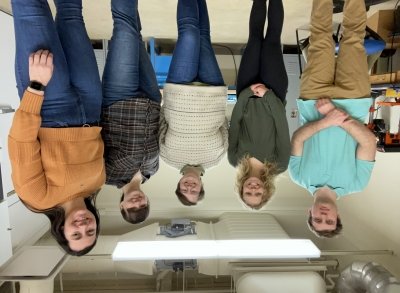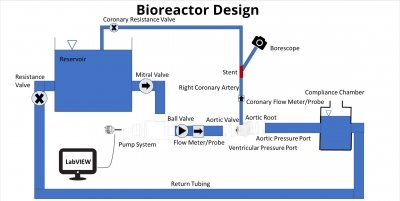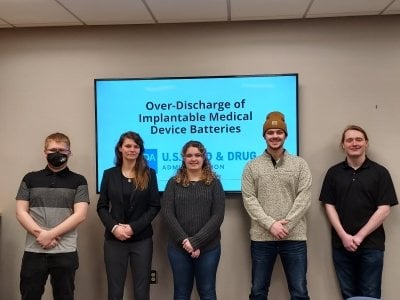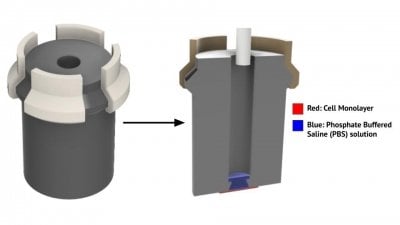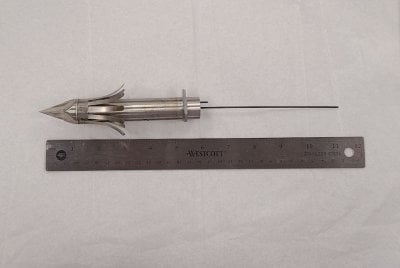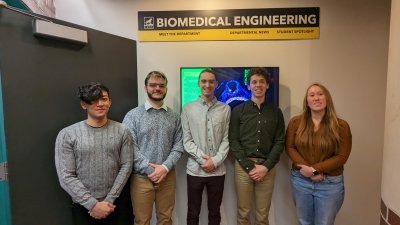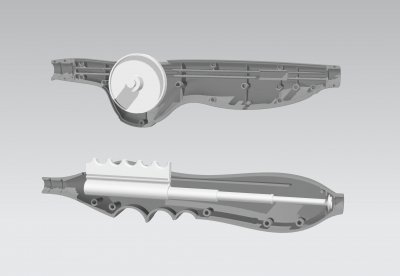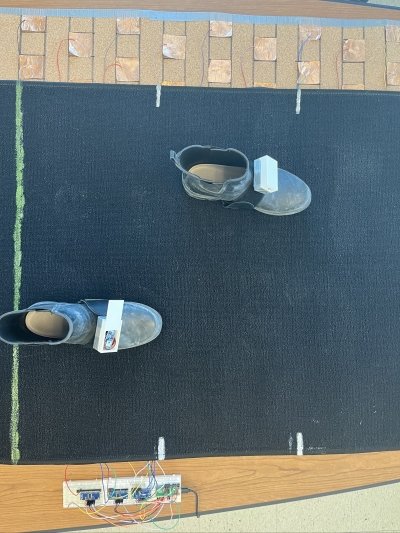203: Anatomical Characteristics, Simulation, Design and Test Development for an Implantable Pulse Generator (IPG) and Lead
We are determining the anatomical characteristics, simulation, design and test development of an Implantable Pulse Generator (IPG). Our project goal is to determine the lead pathway for the electrode anchored to the SCM, from the carotid bifurcation to the implanted device in the chest. We are investigating relative motion between the muscles in the neck to help find the most optimal pathway for the lead.
208: Bioreactor For Degradable Metal Assessment in Vascular Applications
The goal of the project is to design and construct a bioreactor where degradable alloy coronary stents can be tested for degradation under physiological conditions. These conditions include: heart rate, cardiac pressure waveforms, temperature, and flow rate. This project will allow for novel stent alloys and designs to undergo preliminary testing for degradation patterns and rates. This project is in its second phase. In this phase the team will conduct degradation experiments using the system to compare to the data collected from the static experiment performed in phase one.
209: Body Mounted Sensors
The goal of this project is to create a complete system, using commercially available sensors, to measure physiological parameters of fatigue and stress during physical activity. The system displays the physiological state of the user to a non-medically trained viewer. We selected sensors to measure core temperature, blood pressure and blood oxygenation, arrhythmia, and dehydration, respectively. We performed validation testing on the hydration sensor and additional intra-team testing to obtain data for analysis with the developed program. The program extracted data from the sensors to determine when the user has abnormal values, based on literature researched values, and displays the information in a friendly user interface.
214: Design of a Method to Characterize the Depletion Mode Medical Device Battery - Phase 2
Our project goal is to perform electrical and physical characterization of medical lithium-ion secondary batteries when exposed to overdischarge for varying cycle lengths.
216: Device to Measure the Mechanical Properties of Cell Monolayer
This project sought to develop and test a methodology for determining the mechanical properties of a cell monolayer as a collective unit. The design consists of three crucial components: 1) growing a cell monolayer across multiple materials, 2) removing initial scaffolding material to achieve a free-floating monolayer, and 3) assessing monolayer response to appropriately applied forces using image analysis techniques in order to quantify its deformation and other mechanical properties. This development is anticipated to be useful in numerous biomedical applications as there is a significant lack of devices able to test the mechanical properties of a cell monolayer.
220: Improving Consolidated Implantable Satellite Tag for Right Whales by Reducing Local Tissue Trauma
Our team developed surface modifications to telemetry tags for whales, to improve tissue integration and/or minimize potential for localized infection or tissue trauma. The designed modifications need to integrate as part of tags currently in use in the field, but should also be fundamentally be applicable to any current tag that involves skin penetration. We developed a novel approach to enhance the performance of implantable satellite tags by minimizing tissue damage and increasing tag retention time, determined by metrics developed by the team.
221: Instrument Laser Weld Characterization & Testing
The goal of laser weld characterization and testing is to solidify the use of laser weld tactics in the use of medical instrumentation. The project’s main purpose is to focus on the forces of shear and torsion in two main weld types: an edge and pin weld. The team designed prototypes that focus the forces from human use on the instrument at the site of the laser weld, in order to test shear and torsional loads.
226: Peripheral Interventional Stent Deployment System Handle Evolution
Our team was tasked with reverse engineering and redesigning the Peripheral Interventional Stent Deployment System Handle, the system responsible for deploying a self-expanding stent into the superficial femoral artery. Our redesign optimized cost effectiveness and maximization of deployment length for longer stents compared to both the original model and those of competitors. The project included multiple prototype models for our two main concepts to retract the deployment sheath from over the stent: one utilizing a telescoping rod and the other utilizing a pulley system.
227: Physiological Sensing Using a Smart Port-a-Cath
The goal of this project is to transform a standard port-a-cath into a smart implantable device with the ability to measure common physiological readings while maintaining original functionality. These measurements are achieved through MEMs sensors and a printed circuit board (PCB) incorporated onto the physical port and catheter. The purpose of this device is to allow for remote noninvasive monitoring of cancer patients. Physiological measurements are recorded and uploaded via BLE to an app which will then be accessible by the patients' provider. This project, currently in phase one, involves designing and assembling the PCB, integrating it into a titanium 3D printed port, and evaluating its performance within a phantom environment similar to that of the vena cava.
229: Quantification of Ambulation for Parkinson’s Disease Patients
The objective of this project is to create a sensing technology that can monitor effectiveness of the treatment a Parkinson’s Disease patient is receiving. The main focus of the device will be to analyze the gait of the patient and quantify the results back to the clinician so they can look over the readings of the device. It will be used in conjunction with Medtronic Deep Brain Stimulation (DBS) treatment and used during clinical visits. As a team, we quantified movement metrics for testing of both the wearable and walkable devices. The wearable device is a sensor on each foot and the walkable device is a mat with many sensors.

